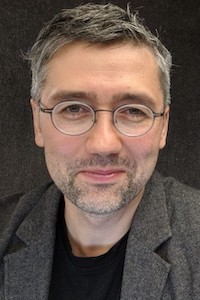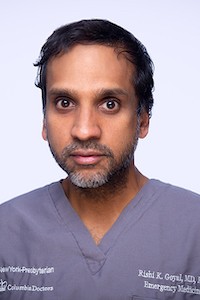What Can We Do to Reduce Vaccine Hesitancy?
Two researchers from Columbia are using AI and their backgrounds in comparative literature to understand why people are often afraid and distrustful of vaccinations and how to convince them otherwise.

Taking Action is a Columbia News series that seeks to showcase efforts from around the university that rely on academic knowledge to tackle real-world challenges in a purposeful way.
According to the CDC, as of April 8, about 33% of Americans have had at least one dose of a COVID vaccine, but public health experts say the United States might need to vaccinate between 70% to 90% of the population to achieve herd, or population, immunity. Getting to that level will ensure that we get the full benefits of the vaccines. Although, three issues can get in the way of achieving this: supply, access, and a public that is confident in, and eager to receive, the vaccine.
At this point in time, demand for vaccines is outstripping supply in most parts of the U.S. and efforts are ongoing to use innovative approaches to making access to vaccines easier. However, when vaccine hesitancy becomes the major obstacle rather than supply or access, how can we overcome this challenge?
A new project from Columbia World Projects in partnership with key Columbia faculty aims to tackle this problem by studying the language used by different groups of people in the U.S. who are vaccine reluctant. Analyzing the data from the project, the Columbia World Projects team will create micro-targeted positive vaccine messaging campaigns for diverse groups.
Taking Action
Along with a multidisciplinary team of researchers, the project leads, Rishi Goyal, assistant professor of emergency medicine at the Columbia University Irving Medical Center and a PhD in comparative literature; and Dennis Tenen, associate professor of English and comparative literature at Columbia University and a long-time associate at Columbia’s Data Science Institute will harness their unique backgrounds—emergency medicine, data science and comparative literature—to unlock the meaning behind the language used by various anti-vaccine and vaccine-hesitant groups and use their analysis to find ways to reach those communities with tailored positive vaccine messages.
Columbia News sat down with Goyal and Tenen to learn how comparative literature, data science, and medicine will work together in this project, why just hitting people over the head with facts will not persuade some people to get vaccinated, and how vaccines are an incontrovertible good.
Q: How did you decide to put into practice your seemingly disparate disciplines in this project?
Rishi Goyal: We thought it'd be great to develop a lab or research project in which we could show that working in these different disciplines—literature, medicine, data science—will provide greater insights.
Dennis Tenen: When you look at the real world, it doesn't have neat boundaries. It's metaphor. It’s policy. It's data. It’s medicine. This is a project that shows that the multiplicity of expertise can better address real world problems.
Q: How did you start this project? What is the issue at the heart of it?

Tenen: We met a few years ago, before COVID. We were looking at hesitancy around the measles vaccine. At the time, the United States was in danger of losing its measles elimination status according to the WHO (World Health Organization). We were also thinking about the various ways in which language shapes our perception of illness and health. Then we started to look at the way people express hesitancy online, and in literature and in the news. As we were thinking about this, the COVID pandemic happened, and the issue of vaccine hesitancy became more pressing.
Goyal: In some ways, the issue is very basic. We are both very interested in the root causes as to why people remain vaccine hesitant, particularly in this historical moment of this pandemic. We believe that if we begin to truly understand the individual reasons for why people are vaccine hesitant, we'll be able to promote vaccine confidence and build trust and get people to the point where they will seek to be vaccinated. Getting high uptake of vaccines, we believe, is the largest driver to return the world back to some semblance of normalcy.
Q: What portion of the United States seems most hesitant?

Goyal: The survey data around vaccine hesitancy are all over the map. The surveys coming from places like the Pew Center and the Kaiser Family Foundation have rates anywhere from 30% to 70%, depending on the day, the week, and the sample size. The data also show decrease in hesitancy among some groups, while among others hesitancy remains high.
Q: Could you briefly describe the project and the methods that you're using?
Tenen: There are three parts to the project. First, and probably most important, we are monitoring online conversation about vaccines from multiple social media sites like Facebook, Reddit, and YouTube comments. We are collecting these conversations. Then we are analyzing the language that people use around vaccination. Finally, we want to make sure that the public outreach campaigns around vaccination are informed by the empirical data that we have collected in the first two phases. Public messaging campaigns should be informed by evidence.
Goyal: We're struck by the fact that a lot of people think they know why everybody's vaccine hesitant. But there hasn’t been a lot of actual data collected on this and sometimes I think data are thought of purely in numerical terms, but we treat language itself as data that we can analyze, interpret, count, and calculate.
Roll Up Your Sleeves
Q: Are you working with local governments?
Goyal: For starters, we're currently working with the Department of Health in Ulster County, New York, and with Maine's CDC to ultimately craft pro vaccine messaging. In addition to white papers that document our findings, we will use automated message generation to generate pro-vaccine messages that reflect the language of vaccine hesitancy and speak directly to individuals’ concerns. We are eager to expand the local entities that we work with in order to craft messages for the breadth of populations who have articulated vaccine hesitancy.
Q: Could you talk about how you're going to leverage artificial intelligence in your project?
Tenen: AI is a very broad and imprecise term. We prefer to say we are using computational methods. When Rishi and I are wearing our hats as comparative literature professors, we observe language, we look for metaphors, we look for figurative language, and we close read. Then we try to understand what does that kind of language entail? We’ve seen metaphors in the past: we are waging a war on drugs, or we're waging a war on disease. Well, that metaphor brings with it a number of other theoretical and emotional constellations that begin to inform our actions. We begin there.
If we want to scale up these close reading insights, we have to leverage computational tools. When we are collecting millions and millions of messages around vaccination, you have to use computational tools to reveal patterns in that data.
Q: What have you observed so far?
Tenen: We are in the very beginning stages of the project. As the COVID-19 pandemic happened and particularly with efforts to develop and launch vaccines, we saw the emergence of a hardening of the vaccine hesitancy communities, and an explosion of conversation online. For example, we are seeing the terms “medical freedom or health freedom.” These groups, in an unexpected way, are using the “my body, my choice” language borrowed from the women's rights movement. They're using the same kind of rhetoric to frame the conversation about vaccination. This is entirely new.
We’ve also observed hesitancy based on religious reasons. For example, it’s very important for some people in Jewish communities to know if a vaccine is kosher, or for some people who are Muslim to know if the vaccine is Halal or for others in certain Hindu communities to know if it contains bovine products.
But we are in the early stages of taking those small ethnographic observations and making them into these computational broad patterns that we can be sure reflect the movement of large communities across the United States.
Goyal: It’s also important to note that vaccine hesitancy is an historical phenomenon. It's not new. People are shocked that it's been around since the first mandatory vaccination laws for smallpox in India and China. Back then, vaccine refusal was often on anti-colonial grounds.
The contemporary rise of vaccine hesitancy before COVID-19 seems to be pegged to Andrew Wakefield’s discredited work on autism and the link between it and the measles, mumps, and rubella (MMR) vaccine, which has been very clearly debunked. It did an incredible amount of damage. That version of vaccine hesitancy is held by a different demographic, such as some parent groups on the West Coast.
What we're seeing now with COVID-19 is a greater politicization and polarization of vaccine hesitancy, but also a growing variety of logic and rhetoric. Vaccine hesitancy is not one thing and cannot neatly be understood in simple demographic terms.
Q: What are your hopes for the outcome of the project?
Goyal: If we can increase vaccine uptake and vaccine confidence overall and show that our methods were able to promote that, that would be incredible. Both of us are also excited and interested in engaging with these methods and the approach. Complex problems are often reduced to very simple solutions and simple root causes. I find that very dissatisfying. If we can keep the complexity of individual opinion alive during the project and still make a difference, that would be quite exciting.